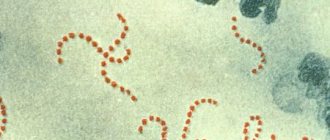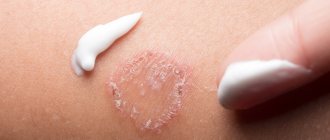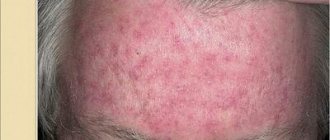YOU MAY ALSO LIKE
Newborn care
How to change diapers: useful tips
Most babies experience diaper rash at least once, even if their diapers are highly absorbent and you change them regularly. In most cases, mild diaper rash will resolve within a few days with simple treatment and your baby's skin will recover. From this article you will learn why diaper rash occurs in children, how it manifests itself, how to treat diaper dermatitis and what to do to prevent it from occurring again.
Diaper dermatitis in the photo
Photo 1. Diaper dermatitis
Photo 2. Diaper dermatitis
Photo 3. Diaper dermatitis
Photo 4. Diaper dermatitis
Causes of diaper dermatitis
The incidence of diaper dermatitis in infants (children under 12 months) is associated with the physiological structure of the skin. Immaturity of the epidermis, underdeveloped connective tissue structures of the dermis, unformed thermoregulation and immune response lead to skin damage and a decrease in protective function. From the photo you can see that the localization of the process is limited to the perineum area, the inner thighs, the anus and buttocks, namely in the places of greatest contact with the exogenous irritant.
Factors leading to diaper dermatitis:
- Mechanical. Regular friction against fabric or a diaper leads to local irritation, hyperemia and microcracks. It is observed in children from 3 to 12 months, which is associated with neuropsychic and physiological development; the activity of movements normally increases. Diaper dermatitis in newborns and babies up to 3 months is caused by insufficient hygiene procedures and care. Small size diaper with elastic compression between the legs.
- Chemical. Contact of the skin with urine (ammonia) and feces (fecal enzymes, opportunistic flora, fatty acids) due to untimely diaper changes. Reaction to fragrances, fragrances, alkaline components of soap, washing powder, moisturizing oil, cream or even diaper.
- Physical. Immature thermoregulatory function with constant wearing of a diaper leads to excessive sweating, a local increase in temperature and humidity (“greenhouse effect”), resulting in increased permeability of the epidermis to chemical compounds and pathogens.
- Conditionally pathogenic and pathogenic microflora. Feces act as an irritant due to dietary habits, enzymatic activity and intestinal bacterial flora. Perianal dermatitis develops, especially when using wet wipes rather than rinsing under warm running water.
A fungal infection can be associated with diaper dermatitis in children. Prescribing antibacterial drugs leads to disruption of microflora, increased activity and proliferation of yeast-like fungus of the genus Candida. Studying the photo helps to see white layers that are easily separated from the surface, while the skin is intensely pink or red with ulcerations.
The big picture
There are several types of diaper rash and they require different treatments. For the treatment and prevention of diaper rash in children, a universal rule is to regularly change a newborn’s diaper. And also thoroughly clean the skin under the diaper and apply protective cream every time you change the diaper. All of these principles apply to basic newborn skin care. If diaper rash does not go away, despite the actions described above, this is a reason to contact your pediatrician for treatment. Diaper rash in children can be caused by a fungal or bacterial infection, in which case a special ointment or medicine will be required for treatment. Even if you change your diaper regularly, you'll likely still experience diaper rash at some point. But the good news is that in most cases, diaper rash goes away within a few days, and the baby's skin recovers and becomes smooth and soft again.
How this article was written The information presented in this article is based on expert advice published by trusted (medical and government) sources such as the American Pediatric Association and the American College of Obstetricians and Gynecologists. A complete list of links to sources used to write this article can be found at the end of the article. The information on this page is not a substitute for professional medical advice. Always consult your doctor for diagnosis and treatment.
Symptoms of diaper dermatitis
The main symptom complex is skin hyperemia, the appearance of dryness, peeling and crusts, after a while weeping occurs and vesicles filled with serous fluid are formed. In advanced cases, the contents of the vesicles become purulent - pustules, and tissue swelling appears. Microcracks form, which quickly turn into ulcers and ulcers.
The child’s general well-being changes, painful sensations appear, he is often capricious, appetite decreases, and sleep is disturbed. Body temperature remains within the normal age range, however, when microbial flora joins, hyperthermia may occur.
It is classified according to the severity and characteristics of the course:
- mild: moderate hyperemia, the skin is pink or pale pink, crusts are possible, eliminated by drying and treatment with special solutions;
- medium: tissue swelling with infiltration is noted, skin color is from bright pink to burgundy, pustules are characteristic;
- severe: the skin is stretched, shiny, red or burgundy in color, pronounced weeping, crusts, ulcerations that tend to merge, deep painful cracks.
The lack of pathogenetic therapy leads to abscess formation, severe intoxication, and sepsis is possible. The condition is life-threatening for the baby.
Treatment of diaper dermatitis
The primary principle in the treatment of diaper dermatitis in infants is proper care and hygiene procedures. With mild to moderate severity, parents can independently prevent dermatosis.
It is recommended to wear disposable diapers, which are changed after each act of defecation and urination; in infants aged 1 to 4 months, the frequency of replacement is 8 or more times. Afterwards, the anogenital area is washed under running warm running water with or without hypoallergenic liquid soap. Use an ironed diaper or towel to blot away any remaining moisture.
To eliminate inflammation, use soft cotton swabs to gently wipe the affected areas of the perineum with a decoction of medicinal herbs. It is impossible to get rid of plaque and crusts by friction. Bathing in a decoction of chamomile, string and calendula is allowed. Air baths of 10-30 minutes a day are required.
Treating the skin before putting on a diaper. If it becomes wet, dry it; if it becomes crusty and dry, moisturize it. Medications:
- Washing with antiseptic solutions: Furacillin solution; decoctions of medicinal plants: chamomile, string, oak bark, calendula, oats.
- Combined powders containing trace elements, minerals, talc and zinc oxide.
- Wound healing agents: Dexpanthenol ointment, Bepanten cream, D-panthenol ointment; Zinc Oxide cream and paste, Desitin cream, Sudocrem; Drapolene cream.
In some cases, the doctor may prescribe more active anti-inflammatory drugs for a short period - hormonal creams, antibacterial or antifungal drugs.
Sometimes antihistamines are prescribed to children with a history of allergies (atopic dermatitis, urticaria, etc.) in order to relieve severe swelling and inflammation. Treatment with the selection of a personal dosage is performed by the treating specialist.
Treatment of severe diaper dermatitis in newborns is carried out in a hospital setting.
Tests and diagnostics
The diagnosis is made based on the collection of anamnesis/complaints and physical examination of the child. It is extremely important to find out what is causing the rash, whether there is pain, restlessness/itching of the skin, especially during urination/defecation, the presence of diarrhea, how often diapers are changed, how the child’s skin is cared for (whether and what detergents, creams, powder), what kind of nutrition the child is on (breast or bottle feeding, whether the child took antibiotics, whether there are any concomitant diseases (gastroenteritis, atopic dermatitis, syndrome). Then the child is examined for the presence of irritations/damage to the skin in the diaper area, the nature of the rash is determined, affected area.
candidiasis diaper dermatitis is suspected, a scraping of the skin of the anogenital zone is performed with laboratory testing for the fungus. Differential diagnosis is carried out with candidiasis , contagious impetigo , psoriasis , seborrheic dermatitis .
Recipes for herbal decoctions:
- Take dry chamomile, string and calendula in equal proportions (10 grams each), add 250 ml of boiling water, let it brew for 30-35 minutes, pass the mixture through a sieve. The decoction is wiped over damaged skin and added to water when bathing.
- 2 tbsp. l. oak bark, brew 180 ml of boiling water, leave for 25-35 minutes, filter. The resulting solution is applied to the skin with a cotton pad or added to the bath when bathing.
Self-treatment of diaper dermatitis may become ineffective if the medicinal plant is incorrectly selected or the required concentration and ratio of ingredients are not observed.
Precautionary measures
Before using such products, a mandatory consultation with a pediatrician or dermatologist is required. The components may have a neutral effect on the health of an adult, but they will cause an allergic reaction in a child.
Before use, the product is tested on a small area of skin. If there is no allergy, then treatment begins. You must always monitor the child’s condition to avoid negative consequences.
Losterin for diaper dermatitis
In the complex treatment of diaper dermatitis in children, zinc-naphthalan paste “Losterin” is used. The paste is well suited for wounds and ulcerations with signs of weeping; it contains 2 main components:
- deresined naphthalan: resinous compounds have antiphlogistic, soothing, antipruritic and drying effects; have an immunocorrective effect, as a result of which they also have an anti-inflammatory and desensitizing effect;
- zinc oxide: has adsorbing, astringent, soothing and drying properties; relieves signs of inflammation and inhibits the proliferation of pathogenic microorganisms; improves normal cell proliferation and promotes healing of microcracks.
Zinc-naphthalan paste Losterin can be prescribed as part of a complex treatment of dermatitis, used as monotherapy during the rehabilitation period, and also used for the purpose of prevention and maintenance of results.
Consequences and complications
After the first signs of film dermatitis appear, in the absence of timely treatment, adequate care of the child’s skin and failure to eliminate provoking factors, rapid progression of the disease and deterioration of the skin condition are observed. In almost 15% of children, a severe form develops within 1-2 days, and they have a tendency to relapse in cases of diarrhea / in the presence of the slightest errors in care. Severe and complicated forms of it are more common in children with signs of lymphatism and transient failure of cellular immunity .
Quite serious complications of diaper dermatitis include the development of a purulent-inflammatory process in the form of impetigo , abscesses , infiltrates, often accompanied by symptoms of intoxication, fever, disturbances in appetite, stool patterns, sleep, and malnutrition . At the same time, the most common pathogen is fungal flora and Staphylococcus aureus. With dominant candidal inflammation, a pronounced, rapidly progressing clinical picture is observed, forming extensive affected areas in the form of papules and vesicles in the genital area, inguinal folds, thighs, buttocks, and abdomen.
Prevention of diaper dermatitis
Preventive measures are aimed at preventing the development of diaper rash; experts recommend:
- changing the diaper after each act of defecation and urination;
- choosing a diaper with gel filler, the gel better absorbs excess moisture;
- consider the size and gender of the child when purchasing a diaper;
- do not use cream and powder at the same time, the resulting lumps collect in natural folds and irritate the epidermis;
- do not use gauze diapers;
- maintain a sleep-wake schedule with air baths;
- carefully remove droplets of water by blotting;
- wearing clothes made from natural fabrics;
- dress your baby according to the season to avoid overheating and excessive sweating;
- in the autumn-spring period, give the child vitamin D to prevent rickets.










